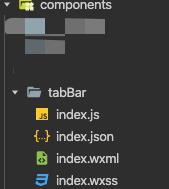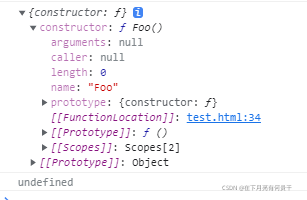目录
- 1、前言
- 2、原型链继承
- 3、构造函数继承
- 4、组合继承
1、前言
首先学习继承之前,要对原型链有一定程度的了解。
不了解可以去先阅读我另一篇文章,里面对原型链有一个较为详细的说明:JavaScript 原型链详解。
如果已经了解请继续。
之前写过一篇博文将继承方式全部列出来了,不过我发现一口气看完过于长了,也不利于吸收知识,所以我先将组合继承部分划分出来,后续会把寄生部分补上。
2、原型链继承
父类实例作为子类的原型
子类创造的两个实例的隐式原型__proto__指向父类的那个实例
而父类的实例的隐式原型__proto__又指向父类的原型father.prototype
根据原型链的特性,所有子类的实例能够继承父类原型上的属性。
阅览以下这张图可以配合代码理解清晰:

//父类
function father() {
this.fatherAttr = ["fatherAttr"];
}
//父类的原型上的属性
father.prototype.checkProto = "checkProto";
//子类
function child() {}
// 将father实例作为child这个构造函数的原型
child.prototype = new father();
child.prototype.constructor = child;
//两个子类实例
const test1 = new child();
const test2 = new child();
console.log("测试1:");
console.log("test1:", test1);
console.log("test2:", test2);
console.log("test1.fatherAttr:", test1.fatherAttr);
console.log("test2.fatherAttr:", test2.fatherAttr);
console.log("测试2:");
test1.fatherAttr.push("newAttr");
console.log("test1.fatherAttr:", test1.fatherAttr);
console.log("test2.fatherAttr:", test2.fatherAttr);
console.log("测试3:");
console.log("test1.checkProto:", test1.checkProto);
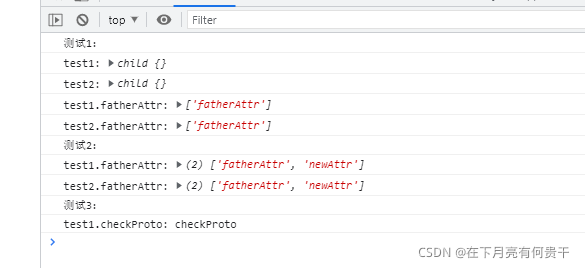
特点:
- 两个实例对象都没有
fatherAttr属性,但是因为父类的实例会拥有fatherAttr属性,且现在父类的实例作为child的原型,根据原型链,他们可以共享到自己的构造函数child的原型上的属性。(测试1) - 因为只有一个父类的实例作为他们的原型,所以所有实例共享了一个原型上的属性
fatherAttr,当原型上的属性作为引用类型时,此处是数组,test1添加一个新内容会导致test2上的fatherAttr也改变了。(测试2)(缺点) child构造函数不能传递入参。(缺点)- 实例可以访问到父类的原型上的属性,因此可以把可复用方法定义在父类原型上。(测试3)
3、构造函数继承
将父类上的this绑定到子类,也就是当子类创造实例时会在子类内部调用父类的构造函数,父类上的属性会拷贝到子类实例上,所以实例会继承这些属性。
//父类
function father(params) {
this.fatherAttr = ["fatherAttr"];
this.params = params;
}
//父类的原型上的属性
father.prototype.checkProto = "checkProto";
//子类
function child(params) {
father.call(this, params);
}
//两个子类实例
const test1 = new child("params1");
const test2 = new child("params2");
console.log("测试1:");
console.log("test1:", test1);
console.log("test2:", test2);
console.log("test1.fatherAttr:", test1.fatherAttr);
console.log("test2.fatherAttr:", test2.fatherAttr);
console.log("测试2:");
test1.fatherAttr.push("newAttr");
console.log("test1.fatherAttr:", test1.fatherAttr);
console.log("test2.fatherAttr:", test2.fatherAttr);
console.log("测试3:");
console.log("test1.checkProto:", test1.checkProto);
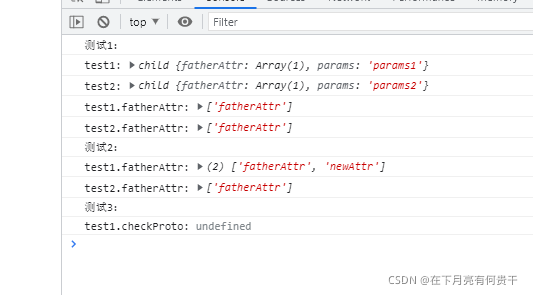
特点:
- 两个实例对象都拥有了拷贝来的
fatherAttr属性,所以没有共享属性,创造一个实例就得拷贝一次父类的所有属性,且因为不能继承父类原型,所以方法不能复用,被迫拷贝方法。(测试1)(缺点) test1添加一个新内容只是改变了test1自己的属性,不会影响到test2。(测试2)child构造函数可以传递参数,定制自己的属性。(测试1)- 实例不能继承父类的原型上的属性。(测试3)(缺点)
4、组合继承
结合原型链继承和构造函数继承,可以根据两种继承特点进行使用。
//父类
function father(params) {
this.fatherAttr = ["fatherAttr"];
this.params = params;
}
//父类的原型上的属性
father.prototype.checkProto = "checkProto";
//子类
function child(params) {
//第二次调用了父类构造函数
father.call(this, params);
}
// 将father实例作为child构造函数的原型
child.prototype = new father();//第一次调用了父类构造函数
child.prototype.constructor = child;
//两个实例
const test1 = new child("params1");//从这里跳转去子类构造函数第二次调用了父类构造函数
const test2 = new child("params2");
console.log("测试1:");
console.log("test1:", test1);
console.log("test2:", test2);
console.log("test1.fatherAttr:", test1.fatherAttr);
console.log("test2.fatherAttr:", test2.fatherAttr);
console.log("测试2:");
test1.fatherAttr.push("newAttr");
console.log("test1.fatherAttr:", test1.fatherAttr);
console.log("test2.fatherAttr:", test2.fatherAttr);
console.log("测试3:");
console.log("test1.checkProto:", test1.checkProto);
console.log("测试4:");
delete test1.fatherAttr
console.log("test1:", test1);
console.log("test1.fatherAttr:", test1.fatherAttr);
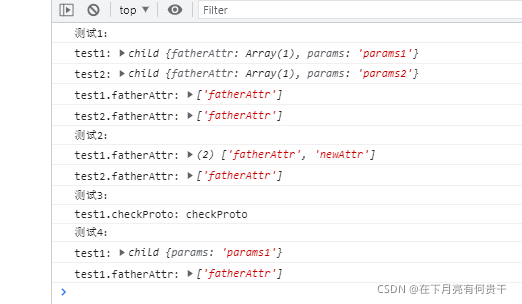
特点:
- 两个实例对象都拥有了拷贝来的
fatherAttr属性,创造一个实例就得拷贝一次父类的所有属性(构造函数继承特点,测试1),但是能访问父类原型,可以把复用方法定义在父类原型上。(原型链继承特点,测试1) test1添加一个新内容只是改变了test1自己的属性,不会影响到test2。(构造函数继承特点,测试2)child构造函数可以传递参数,定制自己的属性。(构造函数继承特点,测试1)- 实例能继承父类的原型上的属性。(原型链继承特点,测试3)
- 调用了两次父类的构造函数,生成两份实例,创建子类原型链一次,用子类创建实例时,子类内部里面一次,第二次覆盖了第一次。(缺点)
- 因为调用两次父类构造函数,如果用delete删除实例上拷贝来的
fatherAttr属性,实例仍然拥有隐式原型指向的父类实例上的fatherAttr属性。(原型链继承特点,测试4)(缺点)
到此这篇关于JavaScript组合继承详解的文章就介绍到这了,更多相关JavaScript组合继承内容请搜索NICE源码以前的文章或继续浏览下面的相关文章希望大家以后多多支持NICE源码!
